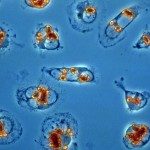Link to Pubmed [PMID] – 36848551
Link to DOI – 10.1073/pnas.2220828120
Proc Natl Acad Sci U S A 2023 Mar; 120(10): e2220828120
Trypanosomatid pathogens are transmitted by blood-feeding insects, causing devastating human infections. These parasites show important phenotypic shifts that often impact parasite pathogenicity, tissue tropism, or drug susceptibility. The evolutionary mechanisms that allow for the selection of such adaptive phenotypes remain only poorly investigated. Here, we use Leishmania donovani as a trypanosomatid model pathogen to assess parasite evolutionary adaptation during experimental sand fly infection. Comparing the genome of the parasites before and after sand fly infection revealed a strong population bottleneck effect as judged by allele frequency analysis. Apart from random genetic drift caused by the bottleneck effect, our analyses revealed haplotype and allelic changes during sand fly infection that seem under natural selection given their convergence between independent biological replicates. Our analyses further uncovered signature mutations of oxidative DNA damage in the parasite genomes after sand fly infection, suggesting that Leishmania suffers from oxidative stress inside the insect digestive tract. Our results propose a model of Leishmania genomic adaptation during sand fly infection, with oxidative DNA damage and DNA repair processes likely driving haplotype and allelic selection. The experimental and computational framework presented here provides a useful blueprint to assess evolutionary adaptation of other eukaryotic pathogens inside their insect vectors, such as Plasmodium spp, Trypanosoma brucei, and Trypanosoma cruzi.






